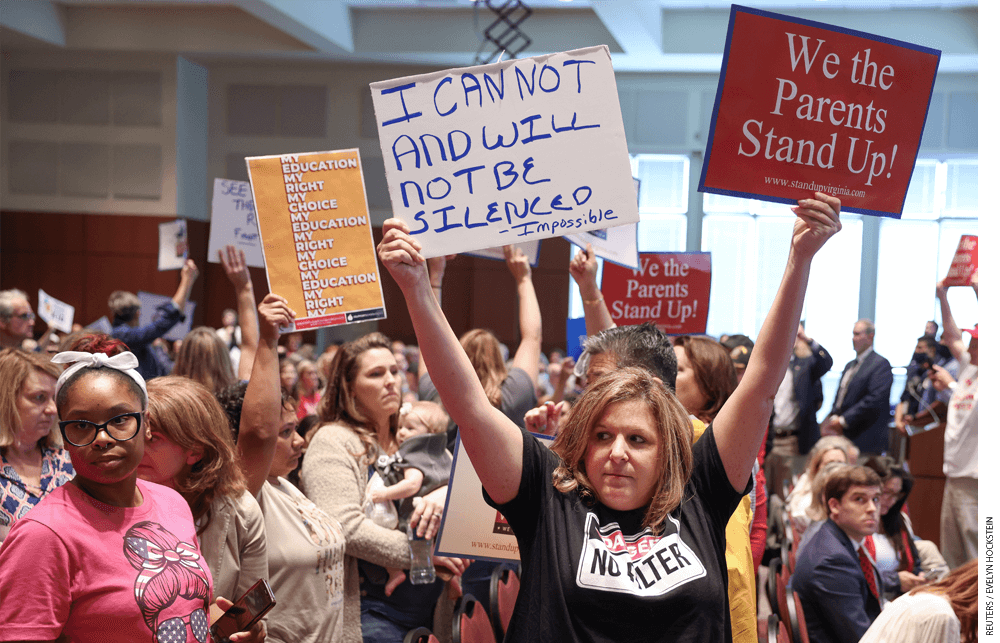
“I don’t think parents should be telling schools what they should teach,” commented former Virginia governor Terry McAuliffe, a Democrat, while seeking a return to office in 2021. His Republican opponent, Glenn Youngkin, wove McAuliffe’s remark into a campaign that was making education its centerpiece. When Youngkin defeated McAuliffe in an upset, many pundits declared parent activism to be a deciding factor.
Virginia was hardly the only place where controversies over parent rights boiled over in the past year. Activists fed up with school closures, masking policies, and curricular choices interrupted school-board meetings around the nation. The National School Boards Association complained about threats directed at board members, provoking an investigation by the U.S. Attorney General. Three school-board members in San Francisco were defeated in a recall election after voting to rename Abraham Lincoln High School and eliminate the exam requirement for admission to prestigious Lowell High School (see “School Board Shakeup in San Francisco,” features, Fall 2022).
The parental protests, together with school responses to the Covid pandemic, acquired a partisan edge. Republican and Democratic governors regularly disagreed about the necessity of mask wearing, social distancing, and vaccinations for the young. The districts that kept school doors closed longest were usually located in Democratic-leaning places the media labels blue. The 18 states that enacted school-choice legislation in 2021 and 2022 are mostly tinted red, or Republican-leaning (see “School Choice Advances in the States,” features, Fall 2021).
How have American parents at large responded to these conflicts? Have measures designed to slow the Covid pandemic antagonized them? Have progressive attempts to introduce concepts rooted in Critical Race Theory into school curricula weakened parental attachments to district schools? Are more parents fleeing to alternative forms of schooling? Have education policy and practice become more partisan? We asked about these matters in the Education Next survey administered online to a nationally representative sample of parents of school-age children in May 2022 (for survey details, see methodology sidebar in our companion essay, “Partisan Rifts Widen, Perceptions of School Quality Decline,” features).
Our findings are mixed. On one hand, parents’ distress about their children’s academic and social-emotional wellbeing subsided sharply in spring 2022 from the heights reached in fall 2021, when many schools closed classrooms and shifted to online learning. For example, the percentage of children who have parents who say they are “very satisfied” with the instruction and activities provided by their child’s school increased to 48% from 31% between fall 2020 and spring 2022. We also find that parents of nearly two thirds of all schoolchildren are satisfied with their school’s approach to teaching about slavery, race, and racism. On the other hand, the percentage of parents giving their local schools a grade of A or B declined to 59% in 2022 from 64% in 2020. During this same period, the percentage of parents choosing an alternative to the traditional public school increased, and parents expressed higher levels of satisfaction with their child’s school if their student was attending a private or charter school rather than a district school.
Partisanship is fully apparent when parents report on their children’s behaviors, school policies, and their assessments of how measures taken by schools to combat Covid are affecting their children’s academic and social wellbeing. Children of Democratic parents in states that Joe Biden won in the 2020 election are more than twice as likely to be vaccinated than children of Republicans in states won by Donald Trump. Similarly, children in blue states were more likely than those in red states to be told they must wear a mask during the 2021–22 school year. According to their parents, children of Republicans were more likely than those of Democrats to have suffered, rather than benefitted, both academically and socially, from measures taken by schools to combat Covid. Children in blue states are more likely to attend a school where parents view fighting and bullying as a problem than those in red states. Republican parents are more likely to complain about how their child’s school approaches the topics of slavery and racism if they live in a blue state than a red state. The reverse is true for Democrats.
Signs of restlessness on the part of some families notwithstanding, the overall picture shows less change than media reports portray. A wholesale mass exodus from traditional public schools has not occurred. And despite partisan differences in responses to Covid, the parents of children in states both blue and red report less anxiety about their children’s academic and social progress than was the case two years earlier.
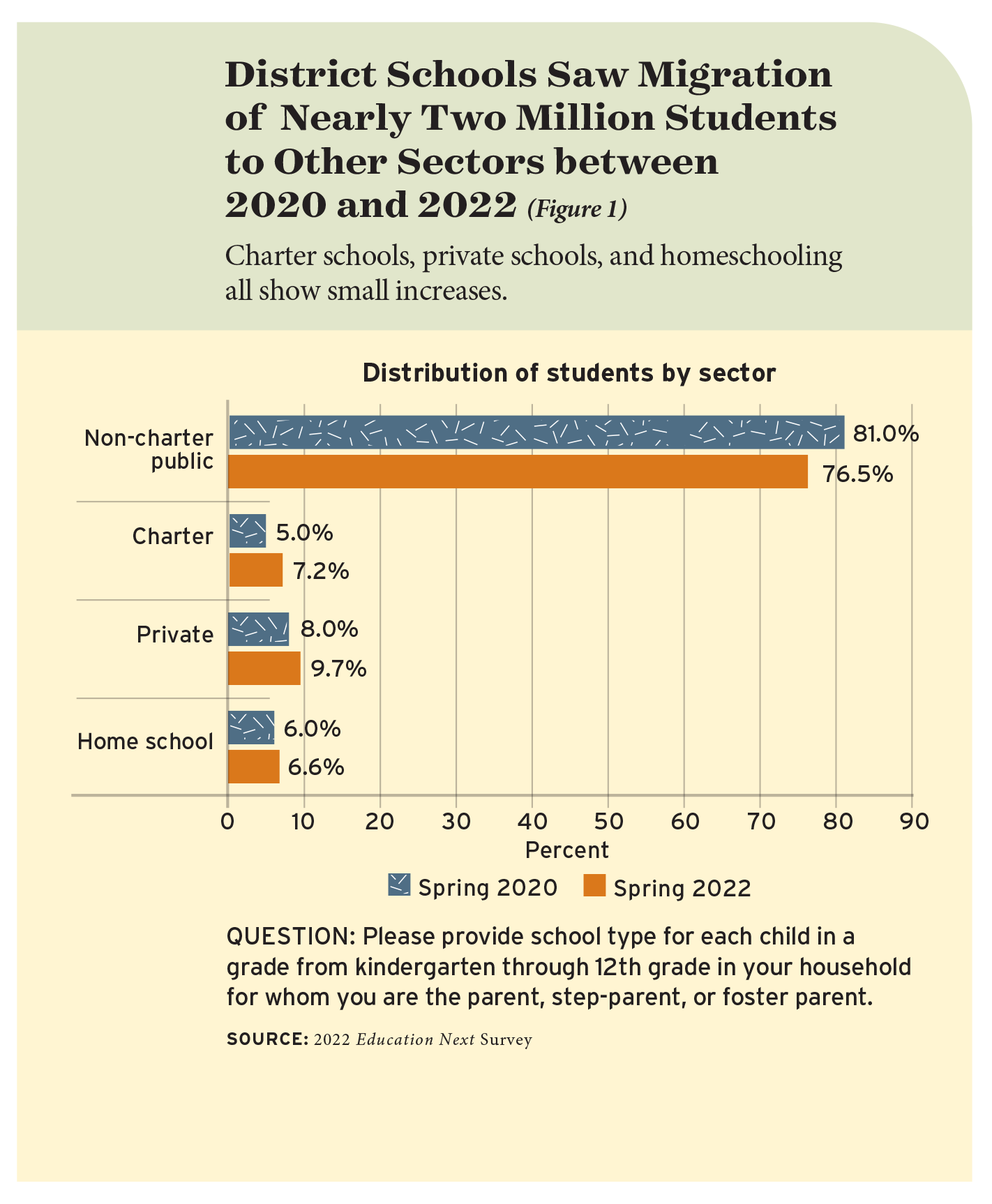
Student Enrollment by School Sector
“Where are the students? For a second straight year, school enrollment is dropping.”
“Declining enrollment clobbers California’s schools.”
“Enrollment Declines Haunt School Districts.”
These headlines from national and statewide news media are not misleading. The U.S. Department of Education, which releases enrollment data two to three years after events have occurred, says a decline of 1.6 million traditional-public-school and public-charter-school students occurred between fall 2019 and fall 2020. Burbio, an organization that tracks districts that account for 90% of all enrollments and on a faster timeline, reports that “nationally, middle school (grades 6–8) shows a 2.2% decline for 2021/22 versus 2020/21.”
Several factors are contributing to enrollment decline. The U.S. birth rate fell between 2014 and 2019, though a growth in immigrant families partially offsets that trend. Some parents kept preschool, kindergarten, and 1st-grade children at home when infection fears were rampant and school buildings were closed. A larger than typical share of adolescents dropped out when schools went digital and job opportunities proliferated.
Even among students who remained in school, the traditional public sector lost ground. Our polling data indicate that district-operated schools lost 4% of student enrollments to other types of schooling between 2020 and 2022. In spring 2020, 81% of schoolchildren were said by their parents to be enrolled in district schools. In November 2020, at the pandemic’s height, that percentage had tumbled to 72%. This 9-percentage-point drop might partly have been the result of actual sector shifts, but it is also likely that some parents were uncertain of how best to classify their child’s school when teaching was online. For whatever reason, the district share bounced back to 77% by the time of Education Next’s spring 2021 poll, when most district schools had resumed in-person instruction. Now, our current survey shows no further change in district enrollment as of spring 2022, leaving the district share 4 percentage points below what it had been two years earlier (see Figure 1). If that percentage is accurate, it means that nearly 2 million students have shifted from traditional public schools to alternative school arrangements.
All three of the alternatives to district schools—charter, private, and homeschool—appear to have gained from the shift away from the district school. The private-school share ticked up to 10% in 2022, as compared to 8% in spring 2020. The charter-school share climbed to 7% from 5% over the same period, while the homeschooling share edged upward to 7% from the surprisingly high 6% level registered in 2020, which itself had constituted a doubling of the 3% share in 2016 reported by the U.S. Department of Education. These percentages are all subject to survey error, but consistency over Education Next’s three most recent surveys, coupled with reports of enrollment declines from state and district agencies, as well as growth signals from the private, charter, and homeschooling sectors, suggest that a modest but significant shift is occurring in the choices families are making about the schools they want their children to attend. Still, there is no indication of wholesale abandonment of the traditional public school.
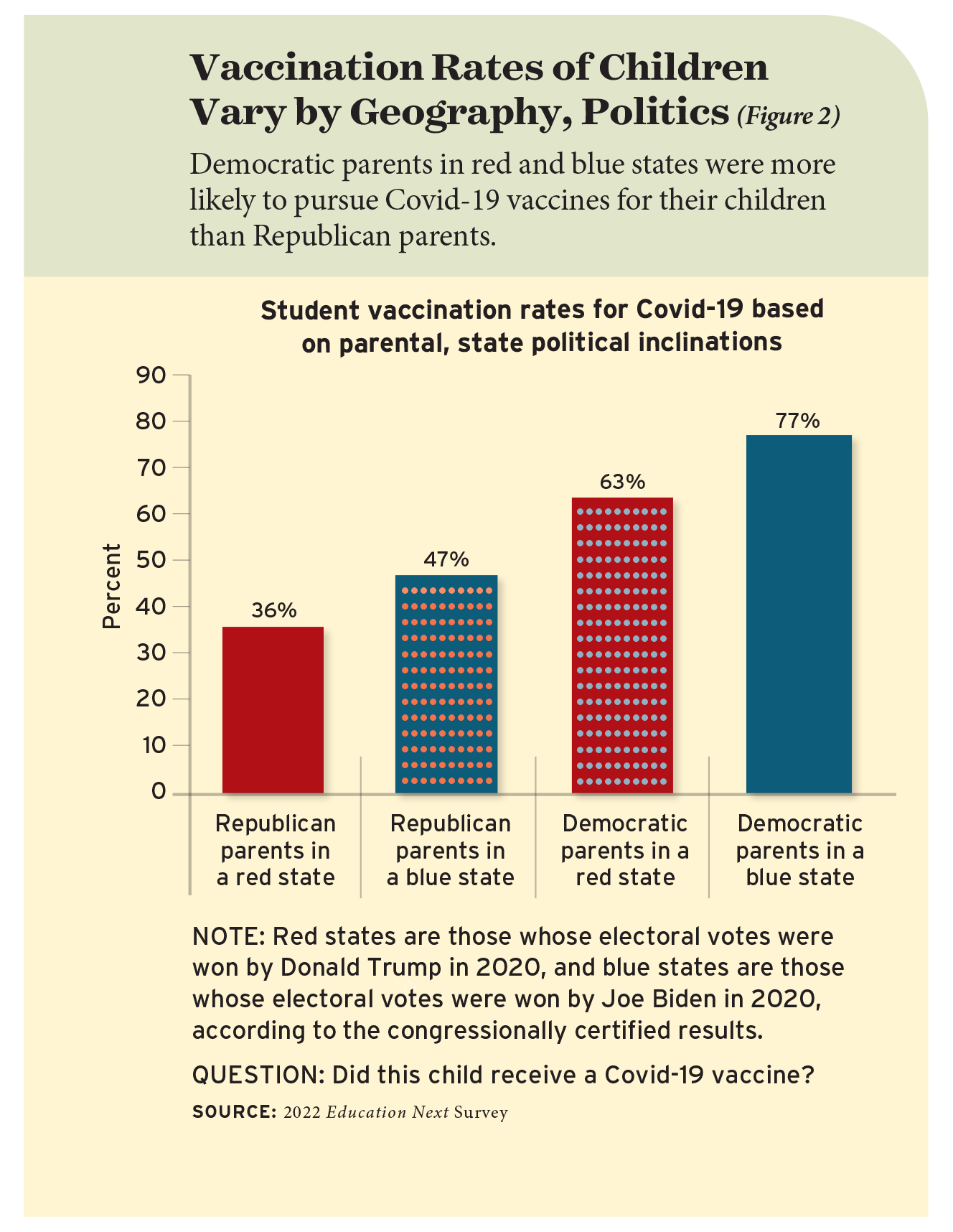
Parent Satisfaction and Assessment of Learning Loss
Some of the public rhetoric would have one think otherwise. “Now, there’s a new interest group—parents. They are never going to unsee what they saw in 2020 and 2021, and they’re going to fight to make sure they never feel powerless when it comes to their children’s education again,” opines Corey DeAngelis, a senior fellow at the American Federation for Children. Across the country, parent organizations are fighting to improve educational opportunities and outcomes for low-income students (see “Beyond Bake Sales,” features, Fall 2022). Former U.S. Secretary of Education Betsy DeVos, in her 2022 book Hostages No More, asserts that the “visionaries who have fought [the] fight [for education freedom] have gained potent new allies: the millions of American parents who are fed up with being considered nuisances and dismissed by the public school establishment.” It is true that, at the height of the pandemic, parental anxiety about their children’s education had intensified. But apprehension receded substantially by spring 2022.
Parents’ concerns likely diminished in part because schools relaxed policies designed to minimize Covid spread. Although parents of nearly 80% of children said they were required to wear masks at some point during the 2021–22 school year, by May 2022, only 11% of children were required to do so, according to their parents.
However, 44% of children still had not received a Covid vaccination by that time, according to their parents. The percentage who remained unvaccinated ranged from a high of 58% for children in kindergarten through 2nd grade, to 48% for those in 3rd through 5th grade, to 40% for those in middle school, down to 31% for high school students.
Differences in vaccination rates also varied with the political coloration of the child’s home state. Only 36% of students who have Republican parents and live in a red state had been vaccinated, as compared to 47% of those with Republican parents in a blue state, 63% of those with Democratic parents in a red state, and 77% of those with Democratic parents in a blue state (see Figure 2). The difference between a typical Republican in a red state and a typical Democrat in a blue state is greater than two-to-one.
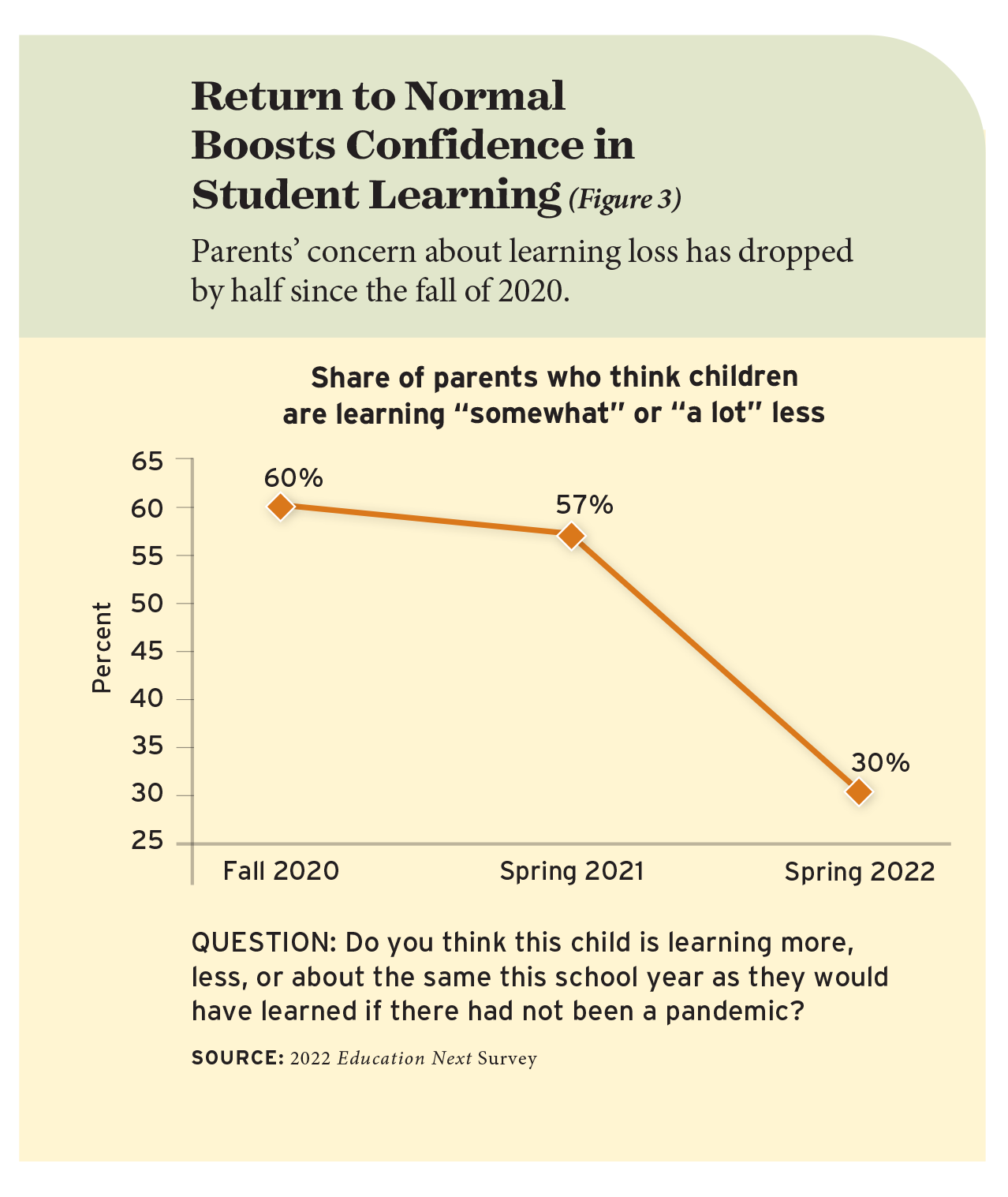
Mask mandates also varied dramatically by partisanship: 34% of students whose parents are Republicans and live in red states were never required to mask up in the 2021–22 school year, as compared to 20% of those in blue states, 21% of those with Democratic parents living in red states, and 5% of those with Democratic parents living in blue states. However, mask mandates declined rapidly by the end of the school year nationwide. Only 14% of children of blue-state Democrats and 2% of children of red-state Republicans were said by their parents to be attending a school that still had a mask mandate as of May.
The relaxation of Covid measures coincided with a marked improvement in parents’ assessments of their children’s wellbeing. In November 2020, Education Next polling data revealed widespread parental worries about the learning loss, social isolation, emotional distress, and physical inactivity induced by school closures, online learning programs, and other measures designed to prevent Covid spread. By spring 2022, however, parental distress had subsided. At this time, only 30% of parents said they thought their child was learning “somewhat” or “a lot” less because of the pandemic, down from 60% in the fall of 2020 (see Figure 3). Similarly, the percentage of parents who thought the measures in place to prevent Covid spread were adversely affecting their child’s academic knowledge and skills fell to 24% in spring 2022 from 36% in fall 2020 (see Figure 4). In 2022, the parents of only 9% of students say they are not confident their child will “catch up” from Covid-related learning loss within a year or two; the parents of the rest either are confident the child will catch up (49% of students) or perceive no learning loss in the first place (43% of students).
Along these same lines, the percentage of students whose parents say Covid-mitigation measures are adversely affecting their child’s social relationships fell to 33% in 2022 from 51% in 2020. Parent perceptions of negative effects on emotional wellbeing fell to 31% of students from 41% over the same period. For physical fitness, the drop was to 26% from 44% of students.
When asked for a more general assessment, parents of 48% of students say in 2022 they are “very satisfied” with the instruction and activities provided at their child’s school, as compared to just 31% in late 2020. The percentage “somewhat” or “very” dissatisfied with the child’s schooling shrank to 11% from 23%.
Even so, Republicans remain considerably less sanguine than Democrats about the ongoing effects of measures taken by schools to fight Covid. Forty-four percent of the children of Democratic parents are said to have benefitted academically from these measures during the 2021–22 school year, and only 18% are said to have suffered from them. But among the children of Republican parents, only 24% are said to have benefitted, and 33% are said to have suffered. A similar pattern obtains for social relationships, emotional wellbeing, and physical fitness in blue states and red states alike. These partisan differences of opinion are especially striking given that the places where large numbers of Republicans reside tended to have less-aggressive mitigation measures in place. In short, the political orientations of parents shaped their assessments of the effects of school measures taken to mitigate Covid on their own children’s academic, social, emotional, and physical wellbeing.
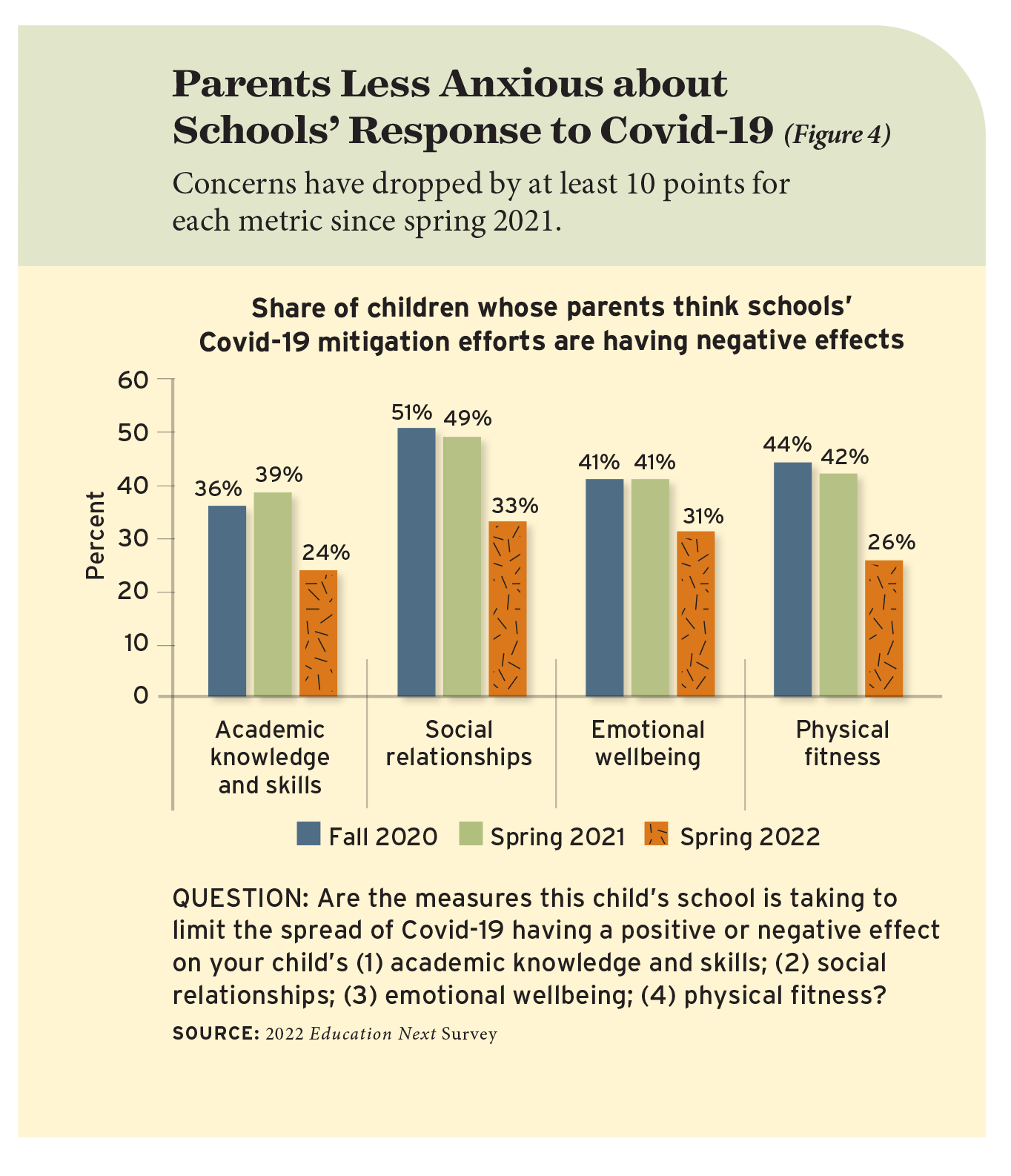
Parent Perceptions by School Sector
Although parental anxiety about potential learning loss during the pandemic declined across the board over the past year, their residual concern varies with the type of school their children attend. Parents of 26% of district children say their children’s academic skills were adversely affected by anti-Covid measures, as compared to parents of 19% of children in private schools and of 15% in charter schools. According to parents, only 14% of private-school children were learning less because of the pandemic during the 2021–22 school year, as compared to 27% of children attending charter schools and 33% of children in the district sector. Small percentages of children have parents who do not think their child will catch up—10% of those at district schools, 5% at charters, and an even smaller percentage at private schools. Children of parents reporting negative effects on their social relationships range from a high of 35% for those in district schools to 29% and 28% for those attending private and charter schools, respectively. A similar pattern appeared when we inquired about the impact of anti-Covid measures on their child’s emotional wellbeing—33%, 29%, and 24% across the three sectors (ordered in the same way). Negative impacts on physical fitness are indicated by parents of 27% of district children, 23% of those in private schools, and 25% of those in charters.
Mask requirements also varied by sector. Only 19% of children in district schools were not required to wear a mask at any point during the school year, but 33% of those in private schools and 26% attending charter schools avoided that requirement. District schools had more-stringent mask requirements, even though they had higher vaccination rates than private schools. Parents report that 59% of district and charter students were vaccinated, but only 48% of those in private school were.
Bullying and Fighting in Schools
With many educators reporting an uptick in violence within schools as in-person instruction resumed, we also asked parents about their experiences with their own children’s schools. The parents of 40% of students say “fighting or bullying” was a problem at the child’s school in 2022, while the parents of 9% say it was a “serious” problem. Children living in blue states are more likely than those in red states to have parents who express concerns about fighting and bullying at school. According to parents, 43% of blue-state children face this problem, as compared to 35% of red-state children. This pattern is similar for children of both Republican and Democratic parents.
The parents of Black and Hispanic students are more likely than those of white students to view fighting and bullying as a problem in their child’s school. For 45% of Hispanic students and 44% of Black students, parents report fighting and bullying as a problem at their school, as compared to 37% of white students. For 16% of Black students, parents report that bullying and fighting are a “serious” problem, a rate nearly twice as high as those for Hispanic and white students.
There are also large differences across school sectors in the perception of fighting and bullying as problems. The parents of only 18% of private-school students report that they are problems, as compared to 30% of charter-school students and 43% of district students.
Instruction on Race
Allegations that Critical Race Theory had leapt from the academy into K–12 curricula stirred considerable controversy during the Virginia gubernatorial race, and many school districts across the country are reconsidering their approaches to teaching about slavery and race relations. To see what parents think, we asked them the following question:
“Some parents think their child’s school places too little emphasis on slavery, racism, and other challenges faced by Black people in the United States. Other parents think their child’s school places too much emphasis on these topics. What is your opinion?”
Most parents seem to be satisfied with the approach taken by their local school: The parents of 64% of children say their school gives “about the right amount” of emphasis to the topic. However, the parents of 25% of students think the topic is given “too little” emphasis and the parents of 11% of students think it is emphasized “too much.” The parents of half of Black students think the topic needs more attention, a view shared by parents of only 25% of Hispanic students and 17% of white students. An even larger difference was between students with Democratic parents and students with Republican parents; 37% of the Democratic parents think this topic is emphasized too little, while 19% of the Republican parents think it is given too much attention.
Parents with children in private schools are more likely than others to believe their child’s school has struck the right balance in this area. The parents of 76% of private-school students report that their child’s school places about the right amount of emphasis on this topic, as compared to 58% and 63% in the charter and district sectors, respectively. The parents of the 42% of charter-school students who are dissatisfied with their school’s approach are evenly split between those wanting more and those wanting less emphasis on this topic. As for district students, the parents of 26% want to see greater emphasis, while the parents of 11% want less.
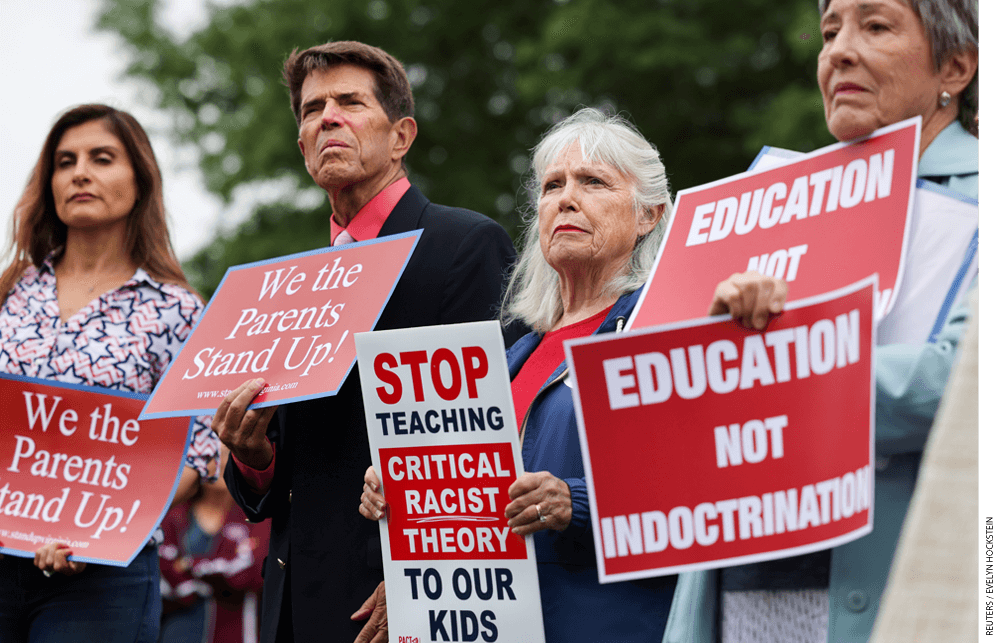
Parental Support for School Choice
Over the past two years, at least 18 states enacted new laws introducing or expanding school-choice options, including relaxation of constraints on charter-school expansion and new and more-expansive tax-credit-funded scholarship and education-savings-account programs. These legislative shifts are echoed by certain shifts in parental opinion. Support for scholarships for low-income children funded by tax credits edged upward by 7 percentage points between 2019 and 2022 to reach 66% of parents. Education savings accounts, too, gained some ground. We inquired about education savings accounts by asking parents whether they favored state policies that provide parents who do not send their children to public school “with money they can spend only for educational expenses, such as private school tuition, tutoring and transportation.” The proportion of parents favoring the policy increased from 45% to 51% between 2017 and 2022. During this same period, support for charter schools rose from 44% to 51% and backing for a universal private-school voucher program increased from 52% to 57%. However, the gains for charters and vouchers predate the onset of the pandemic. When we asked parents whether they favor “school choice” in general (rather than any specific program), a 52% majority said they do and only 29% said they do not, with the remainder not taking a position either way.
In short, no major shifts in parental opinion with respect to school choice have occurred since the onset of the pandemic. Although tax credits and education savings accounts have gained traction, opinion with respect to charters and vouchers, the more familiar forms of school choice, remain much as they had been before Covid. Even in an age of pandemics and political unrest, change comes slowly in American education.
Conclusions
By spring 2022, schools in America had returned, for the most part, to normal practices. Schools were generally open for in-person learning, and masks were usually left at home. Parent satisfaction with schools had risen; parents were less fearful that their children were suffering learning loss. They were less concerned about how Covid-mitigation measures were affecting their children’s social relationships, emotional wellbeing, and physical fitness. They expressed satisfaction with the amount of attention schools were giving to the contentious issues of slavery, race, and racism.
Yet the educational system’s response to the pandemic had left a mark. School districts appear to have lost 4% of their share of K–12 enrollment—a sizable decline. Each of the other school sectors has been less severely disrupted by anti-Covid measures, and, perhaps for this reason, each gained a slightly larger slice of the enrollment pie. Public support for school-choice measures, especially tax-credit-funded scholarships and education savings accounts, increased modestly, though charter schools and vouchers registered no such gains. In other words, gradual change in education has taken place, and partisanship colored parental reaction to Covid measures in various ways, but changes in parental views about the schooling of their children have been nowhere near as dramatic as protagonists in the public debate over the American school would have one believe.
Paul E. Peterson is Henry Lee Shattuck Professor of Government at Harvard University, director of Harvard University’s Program on Education Policy and Governance (PEPG), and senior editor of Education Next. David M. Houston is assistant professor of education policy at George Mason University. Martin R. West, Henry Lee Shattuck Professor of Education at the Harvard Graduate School of Education, is deputy director of PEPG and editor-in-chief of Education Next.
More from the 2022 Education Next Survey: “Partisan Rifts Widen, Perceptions of School Quality Decline: Results of the 2022 Education Next Survey of Public Opinion“
This article appeared in the Winter 2023 issue of Education Next. Suggested citation format:
Peterson, P.E., Houston, D.M., and West, M.R. (2023). Parental Anxieties over Student Learning Dissipate as Schools Relax Anti-Covid Measures: But parent reports indicate some shift away from district schools to private, charter, and homeschooling alternatives. Education Next, 23(1), 20-27.


